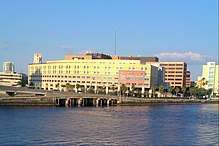Tampa General Hospital
Tampa General Hospital (TGH) is a 1,006-bed teaching hospital in downtown Tampa, Florida. It is located on Davis Islands.
| Tampa General Hospital | |
|---|---|
 | |
 | |

| |
| Geography | |
| Location | Tampa, Florida, United States |
| Organization | |
| Type | Teaching |
| Affiliated university | USF Morsani College of Medicine |
| Services | |
| Emergency department | Level I trauma center |
| Beds | 1,010 |
| Links | |
| Website | www |
| Lists | Hospitals in Florida |
Tampa General Hospital has more than 8,000 team members and is the primary teaching hospital for the USF Health Morsani College of Medicine. TGH is one of five burn centers in Florida. Tampa General Hospital is a level one trauma center, with a five-helicopter fleet, serving 23 counties.[1]
TGH has specialty centers for Orthopedics,[2] Trauma, Obesity, Neurology, Thyroid and Parathyroid Surgery,[3] Head and Neck Surgery, Burns,[4] Cardiac Surgery, Transplantation, Vascular Surgery, Women's Health and OB/GYN, Pediatrics, Neonatal Intensive Care, In-vitro Fertilization, and others. Tampa General Hospital is home to one of the leading organ transplant centers in the country, having performed more than 9,000 adult solid organ transplants, including the state’s first successful heart transplant in 1985.
History
Local legend has it that the placement of what was originally named Tampa Municipal Hospital on Davis Islands was decided in a bunker of the Palma Ceia Country Club golf course. David P. Davis, the developer of Davis Islands, was playing with Dr. J. Brown Farrior, James Swann, and Mayor Chancy of Tampa. The city had considered expanding the existing George Keller Memorial Hospital, located at 306 North Boulevard in what had been the grounds of the Tampa Bay Hotel, but had found such expansion unworkable. Instead, it approached Davis about building upon the Davis Islands land that he had deeded to the city. On the golf course, Davis asked Farrior, who was then chairman of the city's Committee for the Construction of Tampa Municipal Hospital, where he wanted the hospital sited, drawing a rough map of the Islands in the sand. Farrior indicated the tip of the island.[5]
This site is where the hospital construction began in March 1926, voters in the city having approved a USD215,000 bond issue to fund construction in 1924.[6] The hospital building was complete by the next year, the final construction cost having been US$300,000, with patients moving to there from the George Keller Memorial Hospital on 1927-11-15.[5][6][7] James Swann became the Chairman of the board of directors of Tampa Municipal.[5]
The original hospital building, the inscription over whose main entrance archway reads "Tampa Municipal Hospital Memorial to Gordon Keller", was originally surrounded by parkland, and dominated the landscape of Davis Islands. It provided 250 hospital beds for patients. Whilst it still stands today, it has become almost wholly obscured from view by new buildings, and additions to the hospital, that surround it. In 1936, the Gordon Keller School expanded into a new building next to the original.[8]
In 1956, the hospital was renamed to Tampa General Hospital. In 1991, the original building was renamed after Clara Frye, an African American nurse who ran the Clara Frye Hospital for 20 years in the early 1900s, and after whom the Clara Frye Memorial Hospital that existed in West Tampa from 1938 to 1967 had been named. Frye admitted patients of all races, African American or otherwise, to her hospital. The Tampa Municipal Hospital did not admit African American patients until the 1950s.[6]
Since March 2020, 55 cases of COVID-19 have been reported at the hospital.[9]
Emergency Preparedness
Rodney Kite-Powell, the curator of the Tampa Bay History Center, opines that neither the voters of 1924 nor the city's hospital construction committee gave much thought to the location of the hospital, with their primary motivation apparently being merely that the city already owned the land. The location of the hospital has proven to be inconvenient over the years, as Davis Islands were originally accessible from elsewhere via just one bridge (now two).
The impact of Hurricane Elena caused the hospital's main generator plant to be moved out of its previous location in the basement to a higher location, reducing the risk of it being rendered in-operational by flooding, but the hospital site is still vulnerable to the Davis Islands bridges being washed out during a hurricane.
The hospital itself is now largely proofed against storms, despite the continuing vulnerability of the island it sits upon.[10] Recent building work in the 21st century, on the Bayshore Pavilion, has incorporated many of the hospital design recommendations of Washington Hospital Center's ER One project. All critical functions have been placed at or above the second level of the building, above the storm surge level, placing emergency room parking on the first level.[10]
References
- http://www.tgh.org/
- "Orthopedic Center - Tampa General Hospital".
- "Tampa General Hospital - Parathyroid Center". Archived from the original on September 12, 2012.
- "Burn - Tampa General Hospital".
- John Ferguson. "The Farrior Lineage" (PDF). Cite journal requires
|journal=(help) - Steve Rajtar (2007). A Guide to Historic Tampa. The History Press. p. 84. ISBN 9781596292536.
- Robert J. Kaiser (1999). Tampa: The Early Years. Postcard History Series. Arcadia Publishing. p. 84. ISBN 978-0-7385-0225-0.
- Federal Writers' Project (1939). Florida: A Guide to the Southern-Most State. American Guide Series. Best Books on. p. 289. ISBN 9781623760090.
- Reeves, Megan (June 18, 2020). "55 Tampa General Hospital staffers infected with COVID-19 since March". Tampa Bay Times.
- "Showcase One: Bayshore Pavilion at Tampa General Hospital" (Press release). Gresham, Smith and Partners. Archived from the original on 2010-06-26.